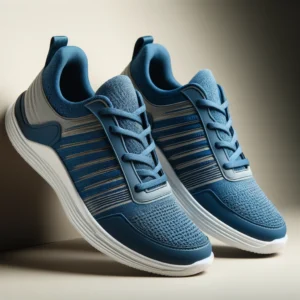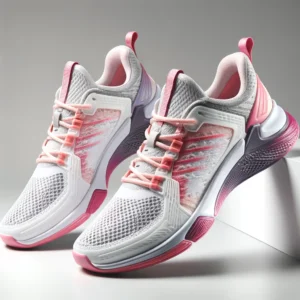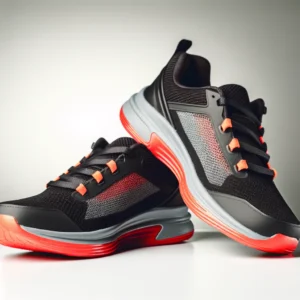Key Features of Training Sneakers:
Comfort and Perfect Fit
Comfort is essential for any training sneaker. Ensure the sneakers fit your feet perfectly, avoiding pressure points and friction that can cause blisters.
Cushioning and Support
Proper cushioning helps absorb impact during workouts, protecting your joints and providing adequate support.Durability and Quality Materials
Durability is crucial to withstand intensive use. Opt for high-quality materials that ensure resistance and longevity.Breathability and Moisture Management
Breathable designs keep your feet dry and comfortable, reducing the risk of infections and odors. Look for sneakers with good ventilation.Stability and Traction
Stability and traction are vital to prevent slips and falls, especially on wet or slippery surfaces.Flexibility and Mobility
The sneakers should offer flexibility to allow natural and smooth movements during exercise.
Recommendations for Comfortable Training Sneakers

Comfort and Perfect Fit
Comfortable training sneakers are essential for any athlete, whether beginner or professional. Here are the features to consider for ensuring comfort and a perfect fit:
High-Density Foam:
Insoles made of high-density foam provide superior cushioning, conforming to the foot’s shape and offering continuous support. This helps distribute weight evenly, reducing pressure on specific points and preventing pain and discomfort.Custom Fit System:
A reliable adjustment system, such as adjustable laces, ensures the sneakers stay securely in place during workouts. This prevents excessive movement within the shoe, which can cause friction and lead to blisters.Breathable Materials:
Breathable materials allow air circulation around the foot, keeping it cool and dry. This is crucial to avoid sweat buildup, which can cause irritation and promote blisters.
Avoiding Blisters with Sports Sneakers
Blisters are one of the most common complaints among athletes. Here are some tips to prevent them:
Choose the Right Socks:
Use technical sports socks that provide extra padding in key areas and are made of moisture-wicking materials.Break in Sneakers Before Intense Use:
Test your sneakers in shorter sessions before wearing them for intense training to identify any areas that might cause friction.Ensure Proper Sizing:
Sneakers that are too tight or too loose can create unnecessary friction. Make sure there’s about a finger’s width of space between your longest toe and the end of the shoe.Use Anti-Friction Products:
Consider applying anti-friction creams or balms on blister-prone areas, such as heels and toes.
Durable Training Sneakers
Durable training sneakers are essential for athletes seeking footwear that can withstand the daily wear and tear of intense exercise. Below are the features that ensure durability in training sneakers:
High-Quality Construction:
Durable sneakers are often made with high-quality materials that offer excellent wear resistance. Look for shoes with reinforced stitching and high-density rubber soles.Reinforcement Technology:
Many brands incorporate reinforcement technologies in key areas, such as heels and toes, to provide greater resistance and extend the shoe’s lifespan.Resilient Rubber Soles:
A tough rubber sole is crucial for durability. This material not only provides excellent grip but also withstands rough surfaces without wearing down quickly.
High-Quality Materials in Sports Footwear

High-quality materials are essential for the durability and performance of training sneakers. Here are some of the most commonly used materials:
Breathable and Reinforced Mesh
Breathable mesh keeps feet cool and dry but must be reinforced in strategic areas to enhance durability without compromising ventilation.Synthetic and Natural Leather
Leather, whether synthetic or natural, is renowned for its durability and adaptability to the foot. It’s ideal for the upper part of the sneaker, offering a combination of strength and flexibility.High-Density EVA Foam
High-density EVA (ethylene-vinyl acetate) foam is used in midsoles to provide long-lasting cushioning. This material is lightweight, resilient, and retains its shape even after extended use.
Durability in Sports Sneakers
Durability is a crucial feature for any training sneaker. Below are key aspects to ensure the resilience of your footwear:
Reinforcements in High-Impact Areas
High-impact zones, such as the heels and forefoot, should be reinforced to withstand constant pressure and wear. Look for sneakers with added protectors in these areas.Advanced Cushioning System
A good cushioning system not only enhances comfort but also protects the internal structure of the sneaker, increasing its resilience and lifespan.Impact Absorption Technology
Impact absorption technologies, like air or gel capsules in the sole, help reduce wear on the sneakers and offer greater durability.
Brand and Model Recommendations
Nike Metcon
Known for their durability and support, Nike Metcon sneakers are ideal for high-intensity workouts and weightlifting.Adidas Powerlift
Designed specifically for weightlifting, these sneakers provide excellent stability and durability.Reebok Nano
Renowned for their resilience and comfort, Reebok Nano sneakers are perfect for functional training and CrossFit.
Training Sneakers Buying Guide
Choosing the right training sneakers can make a big difference in your performance and comfort during exercise. Here’s a complete guide to help you make the best decision for your next pair:
1. Know Your Foot Type
Before buying training sneakers, it’s essential to understand your foot type. This includes knowing your arch shape (high, medium, or flat) and your gait type (pronation, supination, or neutral). This knowledge will help you select sneakers that provide the right support and comfort for your specific foot needs.
2. Identify Your Training Type
The type of workout you do significantly impacts the kind of sneakers you should choose. Here are some recommendations based on different types of exercises:
- Cardio and Running: Look for sneakers with good cushioning and support to absorb repetitive impact.
- Weightlifting: Opt for sneakers with flat and rigid soles for better stability.
- Functional Training or HIIT: Choose sneakers offering lateral support and flexibility.
3. Try Sneakers at the End of the Day
Your feet tend to swell throughout the day, so it’s best to try on sneakers in the evening when your feet are at their largest. This ensures the sneakers won’t feel too tight or uncomfortable during workouts.
4. Seek Professional Advice
Don’t hesitate to get advice from experts at specialized sports footwear stores. They can analyze your gait and recommend the most suitable sneakers for your specific needs.
5. Consider Technology and Materials
Modern training sneakers come with various technologies that enhance performance and comfort. Look for features like:
- EVA Cushioning: Offers excellent impact absorption.
- Breathability Technology: Keeps your feet cool and dry.
- Reinforcements in Key Areas: Increases durability in high-wear zones.
6. Test Sneakers in Motion
Don’t just try them on standing still. Walk, run, and jump a little in the store to ensure the sneakers feel good in motion and provide the necessary support.
7. Check Reviews and Opinions
Before making a purchase, read reviews and opinions from other users. This gives you an idea of the sneakers’ durability and performance in real-world conditions.
Recommended Colors for Training Sneakers Based on Your Sport

Choosing the right color for your training sneakers isn’t just about aesthetics—it can also impact your performance and motivation. Here’s a guide to recommended colors based on the sport you practice:
1. Running and Cardio
- Black: A classic, versatile color that matches any outfit. Black sneakers are easy to maintain and don’t show dirt easily.
- White: Perfect for runners who prefer a clean and fresh look. While they require more upkeep, white sneakers reflect heat, keeping your feet cooler.
- Vibrant Colors (Red, Orange, Yellow): Energetic shades that can boost motivation and visibility, especially for outdoor runs or low-light conditions.
2. Weightlifting
- Gray: A neutral color that conveys seriousness and professionalism. Gray sneakers pair well with any gym outfit and are less likely to show stains.
- Dark Blue: Projects confidence and stability—essential traits for weightlifting.
- Black with Metallic Details: The combination of black and metallic or silver accents adds a touch of sophistication and robustness, perfect for weightlifters.
3. Functional Training and CrossFit
- Red and Orange: Colors that symbolize energy and dynamism, ideal for high-intensity workouts. These hues can increase alertness and motivation during exercises.
- Green: Represents balance and freshness, helping to maintain calm and control in functional training sessions.
- Black and Gray: Durable colors that hide wear and dirt well, making them perfect for intense, varied training sessions.
4. Indoor Sports (Basketball, Volleyball, etc.)
- White and Blue: Bright colors that stand out on the court. Blue conveys tranquility and control, while white offers a clean and crisp look.
- Black with Colorful Accents: Black paired with vivid details, like yellow or red, provides a balance between style and visibility.
- Team Colors: If you’re part of a team, choosing sneakers in your team’s colors can enhance team spirit and cohesion.
For more recommendations, refer to the Men’s Stand section for additional insights
